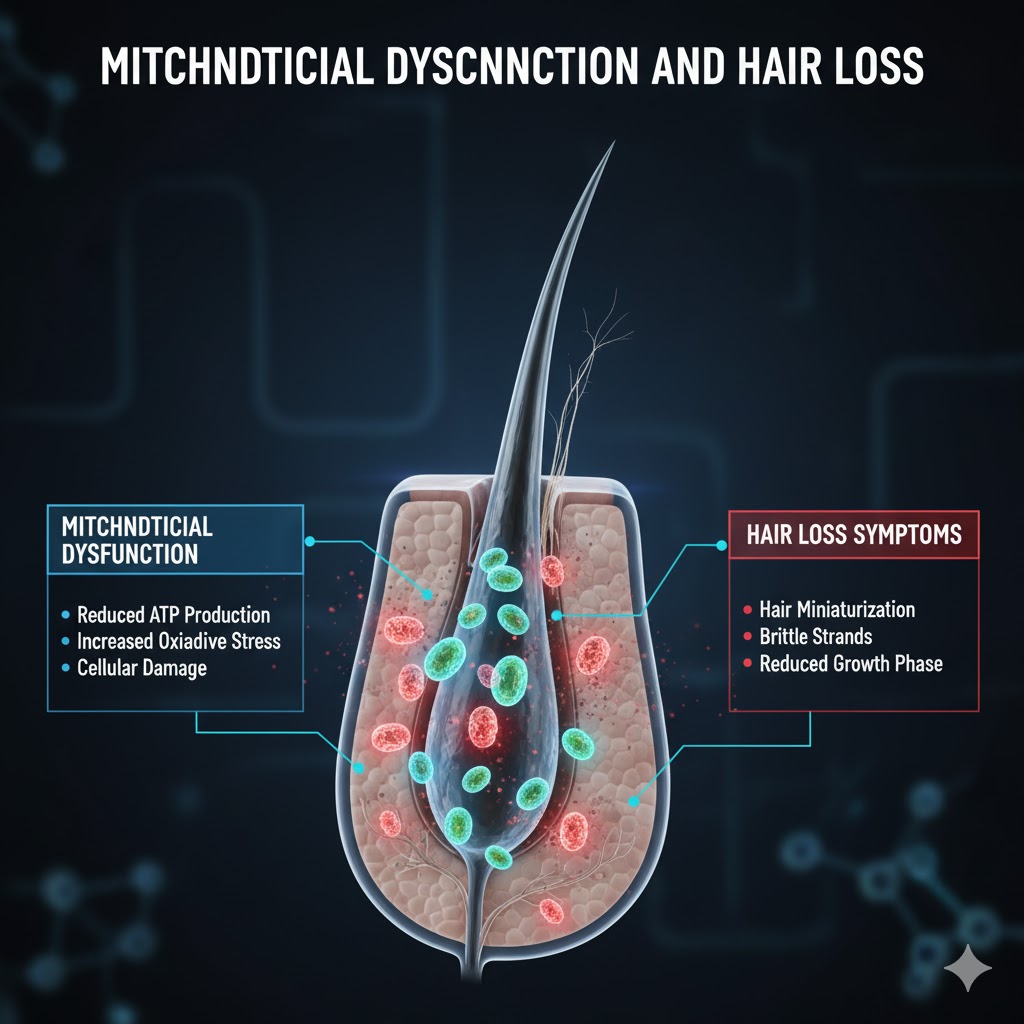When it comes to hair loss, the conversation typically centers around hormones, inflammation, genetics, or lifestyle. But a growing body of research is pointing toward a more fundamental issue at the cellular level—energy production. Specifically, mitochondrial dysfunction is now being considered a potential hidden culprit in hair thinning, premature shedding, and poor regrowth.
At ZMD Hair, we approach hair restoration by uncovering the root cause of loss—not just treating the symptoms. In this blog, we explore the connection between mitochondria, the energy powerhouses of the cell, and the role they may play in the health and vitality of your hair follicles.
What Are Mitochondria?
Mitochondria are small organelles found in almost every cell in the human body. Their primary job? Producing adenosine triphosphate (ATP), the energy currency of cells. Without ATP, cells cannot perform essential functions—including regeneration, repair, and growth.
Hair follicles are among the most metabolically active structures in the body. They require a constant supply of cellular energy to drive the hair growth cycle, particularly during the anagen (growth) phase.
When mitochondrial function is compromised, the follicle’s energy supply drops—potentially interrupting or stalling the hair growth process.
What Is Mitochondrial Dysfunction?
Mitochondrial dysfunction occurs when the mitochondria fail to produce enough ATP to meet a cell’s needs. This can be caused by:
- Oxidative stress
- Genetic mutations
- Chronic inflammation
- Environmental toxins
- Aging
- Nutritional deficiencies
When mitochondria malfunction, cells can become sluggish or even apoptotic (programmed to die). In the case of hair follicles, this can lead to weakened hair production, follicular miniaturization, or even permanent loss of growth capacity.
How Mitochondria Influence Hair Follicles
Energy Supply for Growth Cycles
Hair growth is an energy-intensive process. During the anagen phase, the follicle rapidly divides, differentiates, and pushes keratinized cells upward to form the hair shaft. This cellular machinery depends heavily on ATP.
If ATP production drops due to mitochondrial issues, the follicle may:
- Exit the growth phase prematurely
- Enter telogen (resting) phase too early
- Shed hair more quickly
- Fail to regenerate new hairs effectively
Oxidative Stress and Follicular Aging
Mitochondria are also a major source of reactive oxygen species (ROS)—byproducts of cellular respiration. In healthy cells, antioxidant defenses neutralize these ROS. But in mitochondrial dysfunction, excess ROS can damage DNA, proteins, and lipids within the follicle.
This oxidative stress has been linked to:
- Premature follicle aging
- Pigment loss (graying)
- Miniaturization (as seen in androgenetic alopecia)
- Inflammation that further suppresses follicle function
Mitochondria and Hair Loss: What the Research Shows
Emerging studies suggest mitochondrial dysfunction may be a common denominator in many forms of hair loss:
- Androgenetic Alopecia: Research has shown reduced mitochondrial DNA content and increased oxidative damage in balding scalp tissue.
- Alopecia Areata: Mitochondrial imbalances may play a role in triggering autoimmune attacks on follicles.
- Telogen Effluvium: Sudden stressors that impair mitochondrial energy output may lead to abrupt shedding.
- Aging-Related Thinning: Mitochondrial decline with age may slow cell turnover in follicles, contributing to slower regrowth and finer hair.
While more research is needed, the evidence suggests that restoring mitochondrial health may be a key therapeutic target in combating hair loss.
Factors That Disrupt Mitochondrial Function
There are several systemic and lifestyle contributors that can silently impact mitochondrial performance:
- Chronic stress increases cortisol, which impairs mitochondrial respiration.
- Inflammation from conditions like psoriasis or dermatitis damages mitochondria.
- Poor sleep reduces mitochondrial renewal and repair.
- Nutrient deficiencies (e.g., CoQ10, B vitamins, magnesium, iron) impair ATP synthesis.
- Environmental toxins, including air pollution and heavy metals, generate mitochondrial stress.
- Aging naturally reduces mitochondrial quantity and efficiency.
Understanding and addressing these underlying contributors is essential to long-term hair restoration success.
Supporting Mitochondrial Health for Hair Growth
At ZMD Hair, we incorporate mitochondrial support as part of a holistic approach to hair restoration. Here’s how:
Nutritional Optimization
Mitochondria require key nutrients to function properly, including:
- B vitamins (especially B2, B3, B6, B12)
- Magnesium
- Coenzyme Q10 (CoQ10)
- Alpha-lipoic acid
- Iron and copper
- L-carnitine and NAD+ precursors
We evaluate and address micronutrient deficiencies as part of your personalized treatment plan.
Antioxidant Support
To reduce oxidative damage, we recommend:
- Antioxidant-rich diets (berries, leafy greens, turmeric, green tea)
- Mitochondria-specific antioxidants like CoQ10, glutathione, and resveratrol
- Targeted supplementation when needed
Regenerative Therapies
We use advanced treatments that stimulate mitochondrial repair and ATP production, including:
- Low-Level Laser Therapy (LLLT): Increases ATP output and improves blood flow.
- Platelet-Rich Plasma (PRP): Contains growth factors that support cellular energy metabolism.
- Microneedling: Stimulates mitochondrial response in scalp tissue.
Stress and Sleep Optimization
Sleep deprivation and chronic stress both impair mitochondrial turnover. We support your cellular energy levels by encouraging:
- Healthy sleep hygiene practices
- Cortisol-reducing techniques (mindfulness, yoga, adaptogens)
- Realistic lifestyle adjustments to reduce energy drain on the system
Integrating Cellular Energy into Hair Restoration
While traditional hair restoration often focuses only on the visible scalp or the follicles themselves, we believe deeper healing starts with cellular support. Healthy mitochondria allow your follicles to:
- Extend the anagen (growth) phase
- Improve hair shaft quality and thickness
- Respond more favorably to treatments like PRP and transplants
- Resist miniaturization and premature aging
By incorporating mitochondrial support into your treatment, we optimize not just regrowth—but the quality, speed, and sustainability of your hair recovery.
Conclusion:
Hair loss is more than skin deep. Beneath the surface, your hair follicles are powered by tiny engines—your mitochondria. When those engines falter, even the most advanced hair restoration techniques can struggle to deliver results.
At ZMD Hair, we don’t just look at what’s happening on your scalp—we look at what’s happening inside your cells. By addressing mitochondrial dysfunction, we uncover one of the most overlooked causes of thinning, shedding, and poor follicular recovery.
📞 Ready to restore your hair from the root cause—literally?
Visit ZMDHair.com or call us today to schedule your consultation.




